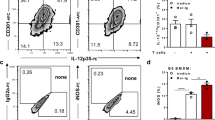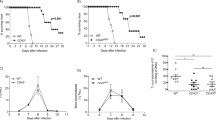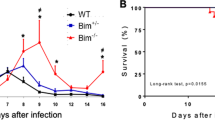Abstract
After apoptosis, phagocytes prevent inflammation and tissue damage by the uptake and removal of dead cells1. In addition, apoptotic cells evoke an anti-inflammatory response through macrophages2,3. We have previously shown that there is intense lymphocyte apoptosis in an experimental model of Chagas' disease4, a debilitating cardiac illness caused by the protozoan Trypanosoma cruzi. Here we show that the interaction of apoptotic, but not necrotic T lymphocytes with macrophages infected with T. cruzi fuels parasite growth in a manner dependent on prostaglandins, transforming growth factor-β (TGF-β) and polyamine biosynthesis. We show that the vitronectin receptor is critical, in both apoptotic-cell cytoadherence and the induction of prostaglandin E2/TGF-β release and ornithine decarboxylase activity in macrophages. A single injection of apoptotic cells in infected mice increases parasitaemia, whereas treatment with cyclooxygenase inhibitors almost completely ablates it in vivo. These results suggest that continual lymphocyte apoptosis and phagocytosis of apoptotic cells by macrophages have a role in parasite persistence in the host, and that cyclooxygenase inhibitors have potential therapeutic application in the control of parasite replication and spread in Chagas' disease.
This is a preview of subscription content, access via your institution
Access options
Subscribe to this journal
Receive 51 print issues and online access
$199.00 per year
only $3.90 per issue
Buy this article
- Purchase on Springer Link
- Instant access to full article PDF
Prices may be subject to local taxes which are calculated during checkout




Similar content being viewed by others
References
Savill, J. Apoptosis: Phagocytic docking without shocking. Nature 392, 442–443 (1998).
Voll, R. E., Herrmann, M., Roth, E. A., Stach, C. & Kalden, J. R. Immunosuppressive effects of apoptotic cells. Nature 390, 350–351 (1997).
Fadok, V. A. et al. Macrophages that have ingested apoptotic cells in vitro inhibit proinflammatory cytokine production through autocrine/paracrine mechanisms involving TGF-β, PGE2 and PAF. J. Clin. Invest. 101, 890–898 (1998).
Lopes, M. F., Veiga, V. F., Santos, A. R., Fonseca, M. E. F. & DosReis, G. A. Activation-induced CD4+ T cell death by apoptosis in experimental Chagas disease. J. Immunol. 154, 744–752 (1995).
Nunes, M. P., Andrade, R. M., Lopes, M. F. & DosReis, G. A. Activation-induced T cell death exacerbates Trypanosoma cruzi replication in macrophages cocultured with CD4+ T lymphocytes from infected hosts. J. Immunol. 160, 1313–1319 (1998).
Savill, J., Dransfield, I., Hogg, N. & Haslett, C. Vitronectin receptor-mediated phagocytosis of cells undergoing apoptosis. Nature 343, 170–173 (1990).
Savill, J., Hogg, N., Ren, Y. & Haslett, C. Thrombospondin cooperates with CD36 and the vitronectin receptor in macrophage recognition of neutrophils undergoing apoptosis. J. Clin. Invest. 90, 1513–1522 (1992).
Silva, J. S., Twardzik, D. R. & Reed, S. G. Regulation of Trypanosoma cruzi infection in vitro and in vivo by transforming growth factor β (TGF-β). J. Exp. Med. 174, 539–545 (1991).
Ming, M., Ewen, M. E. & Pereira, M. E. A. Trypanosome invasion of mammalian cells requires activation of the TGF-β signaling pathway. Cell 82, 287–296 (1995).
Gazzinelli, R. T., Oswald, I. P., Hieny, S., James, S. L. & Sher, A. The microbicidal activity of interferon-γ-treated macrophages against Trypanosoma cruzi involves an L-arginine-dependent, nitrogen oxide-mediated mechanism inhibitable by interleukin-10 and transforming growth factor-β. Eur. J. Immunol. 22, 2501–2506 (1992).
Boutard, V. et al. Transforming growth factor-β stimulates arginase activity in macrophages: implications for the regulation of macrophage cytoxocity. J. Immunol. 155, 2077–2084 (1995).
Pegg, A. E. & McCann, P. P. Polyamine metabolism and function. Am. J. Physiol. 243, C212–221 (1982).
Kierszembaum, F., Wirth, J. J., McCann, P. P. & Sjoerdsma, A. Arginine decarboxylase inhibitors reduce the capacity of Trypanosoma cruzi to infect and multiply in mammalian host cells. Proc. Natl Acad. Sci. USA 84, 4278–4282 (1987).
Hunter, K. J., Le Quesne, S. A. & Fairlamb, A. H. Identification and biosynthesis of N1,N9-bis(glutathionyl)aminopropylcadaverine (homotrypanothione) in Trypanosoma cruzi. Eur. J. Biochem. 226, 1019–1027 (1994).
Mamont, P. S. et al. α-Methyl ornithine, a potent competitive inhibitor of ornithine decarboxylase, blocks proliferation of rat hepatoma cells in culture. Proc. Natl Acad. Sci. USA 73, 1626–1630 (1976).
Corraliza, I. M., Modolell, M., Ferber, E. & Soler, G. Involvement of protein kinase A in the induction of arginase in murine bone marrow-derived macrophages. Biochim. Biophys. Acta 1334, 123–128 (1997).
Prosser, F. H. & Wahl, L. M. Involvement of the ornithine decarboxylase pathway in macrophage collagenase production. Arch. Biochem. Biophys. 260, 218–225 (1998).
Meade, E. A., Smith, W. L. & DeWitt, D. L. Differential inhibition of prostaglandin endoperoxide synthase (cyclooxygenase) isozymes by aspirin and other non-steroidal anti-inflammatory drugs. J. Biol. Chem. 268, 6610–6614 (1993).
Futaki, N. et al. Selective inhibition of NS-398 on prostanoid production in inflamed tissue in rat carrageenan-air-pouch inflammation. J. Pharm. Pharmacol. 45, 753–755 (1993).
Jiang, C., Ting, A. T. & Seed, B. PPAR-γ agonists inhibit production of monocyte inflammatory cytokines. Nature 391, 82–85 (1998).
Celentano, A. M. et al. PGE2 involvement in experimental infection with Trypanosoma cruzi subpopulations. Prostaglandins 49, 141–153 (1995).
Contreras, V. T., Salles, J. M., Thomas, N., Morel, C. M. & Goldenberg, S. In vitro differentiation of Trypanosoma cruzi under chemically defined conditions. Mol. Biochem. Parasitol. 16, 315–327 (1985).
Griffith, T. S., Yu, X., Herndon, J. M., Green, D. R. & Ferguson, T. A. CD95-induced apoptosis of lymphocytes in an immune privileged site induces immunological tolerance. Immunity 5, 7–16 (1996).
Sturmer, A. M., Driscoll, D. P. & Jackson-Matthews, D. E. A quantitative immunoassay using chicken antibodies for detection of native and recombinant α-amidating enzyme. J. Immunol. Methods 146, 105–110 (1992).
Maxfield, S. R. et al. Murine T cells express a cell surface receptor for multiple extracellular matrix proteins. Identification and characterization with monoclonal antibodies. J. Exp. Med. 169, 2173–2190 (1989).
Yokoyama, W. M. et al. Characterization of a cell surface-expressed disulfide-linked dimer involved in murine T cell activation. J. Immunol. 141, 369–376 (1988).
Soares, M. B. P., David, J. R. & Titus, R. G. An in vitro model for infection with Leishmania major that mimics the immune response in mice. Infect. Immun. 65, 2837–2845 (1997).
Green, L. C. et al. Analysis of nitrate, nitrite and [15N] nitrate in biological fluids. Anal. Biochem. 126, 131–138 (1982).
De Mello, F. G., Bachrach, U. & Nirenberg, M. Ornithine and glutamic acid decarboxylase activities in the developing chick retina. J. Neurochem. 27, 847–851 (1976).
Acknowledgements
We thank E. M. Shevach, M. Lenardo and V. Laurentino for the gifts of peptides and antibodies; and M. A. Vannier dos Santos for reading the manuscript and for helpful discussions. This work was supported by CNPq, FAPERJ, FUJB-UFRJ and PRONEX. C.F.L. is a doctoral fellow of Institute of Microbiology (UFRJ).
Author information
Authors and Affiliations
Corresponding authors
Rights and permissions
About this article
Cite this article
Freire-de-Lima, C., Nascimento, D., Soares, M. et al. Uptake of apoptotic cells drives the growth of a pathogenic trypanosome in macrophages. Nature 403, 199–203 (2000). https://doi.org/10.1038/35003208
Received:
Accepted:
Issue Date:
DOI: https://doi.org/10.1038/35003208
This article is cited by
-
Influence of CK2 protein kinase activity on the interaction between Trypanosoma cruzi and its vertebrate and invertebrate hosts
Parasitology Research (2024)
-
Non-self glycan structures as possible modulators of cancer progression: would polysaccharides from Cryptococcus spp. impact this phenomenon?
Brazilian Journal of Microbiology (2023)
-
Inhibition of COX-2 ameliorates murine liver schistosomiasis japonica through splenic cellular immunoregulation
Parasites & Vectors (2022)
-
Axl receptor induces efferocytosis, dampens M1 macrophage responses and promotes heart pathology in Trypanosoma cruzi infection
Communications Biology (2022)
-
Absence of Bim sensitizes mice to experimental Trypanosoma cruzi infection
Cell Death & Disease (2021)
Comments
By submitting a comment you agree to abide by our Terms and Community Guidelines. If you find something abusive or that does not comply with our terms or guidelines please flag it as inappropriate.



